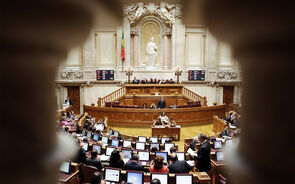Task- "Decoding the Bond Market's Double Talk"
1 Mensagem
|Página 1 de 1
Task- "Decoding the Bond Market's Double Talk"
Este artigo do Task apenas deve ser lido por aqueles que se interessam pelo "bond market" e acreditam que esse mercado é um bom indicador previsional da economia. Quem não acreditar nem se interessar pelo "bond market", é capaz de apanhar uma seca. Eu gostei!
"Decoding the Bond Market's Double Talk"
By Aaron L. Task
Senior Writer
02/27/2003 07:10 AM EST
"The Treasury market is trying to tell us something. But like Alan Greenspan, Treasuries appear to be sending some conflicting signals. Then again, it's entirely possible the Treasury market doesn't know any more about the economy's fate than the Fed chairman does.
On the bearish side, the sub-4% yield on the benchmark 10-year note and Tuesday's all-time low yield of 1.51% for the two-year note suggest the Treasury market isn't expecting much economic growth and accompanying inflation anytime soon. (Inflation undermines the value of future interest payments and thus is anathema to fixed-income investors.)
By contrast, the Treasury yield curve is positively sloped, with the 30-year bond yielding roughly 350 basis points more than the three-month Treasury bill. Historically, such a sharply positively curve augurs strong economic growth. (Conversely, an inverted yield curve -- when short-term yields are higher than long-term yields -- is usually a harbinger of recession, as was the case most recently in 2001.)
Gloom-and-doom types point out that the Treasury market has ignored a host of factors that normally would be negative for bonds, including rising commodity prices, the weakening dollar, and the return of federal deficits and accompanying increased government borrowing. Their interpretation is that the Treasury market is saying the global economy is on the precipice of a calamitous event.
"The pessimistic crowd says 'a [3.75%] 10-year is telling us terrible things are going to happen economically,'" said Jim Bianco, president of Bianco Research in Chicago. "When good economic stats such as [Tuesday's] home sales come out they say 'yeah, but these numbers are about to go south.'"
Earlier this week, Morgan Stanley lowered its global GDP forecast to 2.5% from 2.9% for 2003 and to 3.8% from 4% for 2004. The firm also cut its U.S. GDP estimates to 2.1% from 2.5% for this year and to 4.1% from 4.4% for next.
"The risks remain tilted to the downside of our downwardly revised outlook for the world economy," wrote Stephen Roach, director of global economic analysis at Morgan Stanley. Roach remains concerned about a global deflationary spiral, citing a "lack of policy traction" in a postbubble U.S. economy, Europe's economic inflexibility and Japan's repeated failure to stem economic stagnation. There's also China's entry into the World Trade Organization to consider.
As for the yield curve's message: A positively sloped yield curve is the "natural order of things," observed Jack Malvey, chief global fixed-income strategist at Lehman Brothers. Because owning Treasuries entails risk, securities with longer maturities usually offer higher yields to compensate investors. Therefore, "you have to be careful" in assessing the meaning of a positive yield curve, he said.
However, the yield curve is more steeply positive today than at any time since the early 1990s, when another Bush was in the White House and -- we now know -- the U.S. economy was on the precipice of its longest postwar expansion.
The yield curve's current steepness also reflects the very low fed funds rate, which is suppressing short-term yields.
Taking all that and myriad other factors into consideration, Malvey suggested the bond market's message isn't so cloudy after all. Low yields aren't inconsistent with the steep yield curve, considering the latter is a prognosticator of economic growth, but usually six to nine months out.
"A positively sloped yield curve is less immediately a discounter of good times than emblematic of a still-challenging environment," he said, recalling the yield curve was similarly steep during the recession of the early 1990s and didn't start to flatten until 1994, when the Fed tightened aggressively.
Bond watchers also are contemplating when the Fed might start tightening again, and muse about a repeat of 1994, the worst year in Treasury market history. However, talk of a "bubble" in Treasuries is premature, according to Malvey.
Today's long-term prices are rich "but they could get richer still with another burst of geopolitical risk or if the economy takes a harder turn," he said, suggesting a 3.25% 10-year is not unthinkable. Others believe the Fed's next move might be another easing, which would be consistent with that scenario.
Beyond potential near-term gains, Malvey foresees "little upside price appreciation" over the medium term and sees increased likelihood of a "violent up move" in Treasury yields in the next 12 to 18 months. He predicted the 10-year could yield 4.75% by early 2004.
The point isn't that the bond market is going to implode imminently. But "if you're a real investor, be judicious and think about less bonds vs. more bonds," he said.
Presumably, mutual fund investors who put a record $140.5 billion into bond funds in 2002 and another $13.5 billion in January consider themselves "real investors" vs. short-term traders, and will take appropriate steps.
Accidents & Incidents
Beyond the economy's fate, the bond market is also telling us about inflation expectations or, in this case, the lack of them.
"The steep yield curve is telling me the Fed doesn't think inflation is a problem because they're comfortable keeping the fed funds rate so low," said Bianco. But the "only way" that view of future inflation is right is if there's an "imminent collapse" in crude prices, he argued, citing the rise in energy prices, gold and the CRB/Bridge commodities index in the past year-plus, as well as the dollar's weakness and the more recent uptick in the producer price index. "Without that [collapse] , everything else is wrong."
Although Treasuries are pricing in very little future inflation, they're pricing in some, as opposed to a deflationary environment, observed Brian Wesbury, chief economist at Griffin, Kubik, Stephens & Thompson in Chicago. Given the economic and geopolitical backdrop, he suggested the 10-year's yield would be at 3% if the CRB were under 200 and gold was under $300 per ounce. Instead, the CRB is trading around 250 and gold near $355, and "we can't get back to new low [yields] for the 10-year no matter how bad the economic numbers," the economist said, referring to the October lows of 3.57%. "That tells me there are forces pushing bond yields up even though other forces are pushing them down."
Naturally, those 'other forces' include geopolitics.
"The bond market is caught between Iraq and a hard place," Wesbury quipped. "You have rising commodity prices, but at the same time war and questions about the strength of economy, which is probably related to the war."
Like most economists -- including Greenspan -- Wesbury believes geopolitical uncertainty is holding back the economy and, therefore, keeping long-term Treasury yields artificially low. "If Saddam gave up and left [or] if we invade and things go smoothly, those yields would shoot up," with the 10-year note approaching 5%, he said. "Once the situation in Iraq is resolved, it will remove a huge uncertainty, and by doing so, allow markets to go to more fundamental values," including stocks, which he believes are undervalued.
Clearly that's the consensus view and thus Wesbury openly worried it might prove erroneous, perhaps not unlike the so-called New Economy theories he helped popularize.
Bianco offered another, somewhat variant view on all this, which is becoming his specialty.
"The fed funds rate is at 1.25% because the Fed is keenly focused on the most important economic indicator in the U.S. today: the Dow Jones Industrial Average. The rest is secondary," Bianco said. "We're trying to torture arguments about 'inflation expectations' and what's going on here is a postbubble distortion. [The Fed] just wants Dow 10,000."
The 'fog of war' rationale is certainly more popular, but the lingering aftermath of the stock market mania explains why retail investors continue to flock toward low-yielding, fixed-income instruments. After all, a low-yielding bond beats the pants off of losing another 20% (or more) in the stock market. "
(in www.realmoney.com)
"Decoding the Bond Market's Double Talk"
By Aaron L. Task
Senior Writer
02/27/2003 07:10 AM EST
"The Treasury market is trying to tell us something. But like Alan Greenspan, Treasuries appear to be sending some conflicting signals. Then again, it's entirely possible the Treasury market doesn't know any more about the economy's fate than the Fed chairman does.
On the bearish side, the sub-4% yield on the benchmark 10-year note and Tuesday's all-time low yield of 1.51% for the two-year note suggest the Treasury market isn't expecting much economic growth and accompanying inflation anytime soon. (Inflation undermines the value of future interest payments and thus is anathema to fixed-income investors.)
By contrast, the Treasury yield curve is positively sloped, with the 30-year bond yielding roughly 350 basis points more than the three-month Treasury bill. Historically, such a sharply positively curve augurs strong economic growth. (Conversely, an inverted yield curve -- when short-term yields are higher than long-term yields -- is usually a harbinger of recession, as was the case most recently in 2001.)
Gloom-and-doom types point out that the Treasury market has ignored a host of factors that normally would be negative for bonds, including rising commodity prices, the weakening dollar, and the return of federal deficits and accompanying increased government borrowing. Their interpretation is that the Treasury market is saying the global economy is on the precipice of a calamitous event.
"The pessimistic crowd says 'a [3.75%] 10-year is telling us terrible things are going to happen economically,'" said Jim Bianco, president of Bianco Research in Chicago. "When good economic stats such as [Tuesday's] home sales come out they say 'yeah, but these numbers are about to go south.'"
Earlier this week, Morgan Stanley lowered its global GDP forecast to 2.5% from 2.9% for 2003 and to 3.8% from 4% for 2004. The firm also cut its U.S. GDP estimates to 2.1% from 2.5% for this year and to 4.1% from 4.4% for next.
"The risks remain tilted to the downside of our downwardly revised outlook for the world economy," wrote Stephen Roach, director of global economic analysis at Morgan Stanley. Roach remains concerned about a global deflationary spiral, citing a "lack of policy traction" in a postbubble U.S. economy, Europe's economic inflexibility and Japan's repeated failure to stem economic stagnation. There's also China's entry into the World Trade Organization to consider.
As for the yield curve's message: A positively sloped yield curve is the "natural order of things," observed Jack Malvey, chief global fixed-income strategist at Lehman Brothers. Because owning Treasuries entails risk, securities with longer maturities usually offer higher yields to compensate investors. Therefore, "you have to be careful" in assessing the meaning of a positive yield curve, he said.
However, the yield curve is more steeply positive today than at any time since the early 1990s, when another Bush was in the White House and -- we now know -- the U.S. economy was on the precipice of its longest postwar expansion.
The yield curve's current steepness also reflects the very low fed funds rate, which is suppressing short-term yields.
Taking all that and myriad other factors into consideration, Malvey suggested the bond market's message isn't so cloudy after all. Low yields aren't inconsistent with the steep yield curve, considering the latter is a prognosticator of economic growth, but usually six to nine months out.
"A positively sloped yield curve is less immediately a discounter of good times than emblematic of a still-challenging environment," he said, recalling the yield curve was similarly steep during the recession of the early 1990s and didn't start to flatten until 1994, when the Fed tightened aggressively.
Bond watchers also are contemplating when the Fed might start tightening again, and muse about a repeat of 1994, the worst year in Treasury market history. However, talk of a "bubble" in Treasuries is premature, according to Malvey.
Today's long-term prices are rich "but they could get richer still with another burst of geopolitical risk or if the economy takes a harder turn," he said, suggesting a 3.25% 10-year is not unthinkable. Others believe the Fed's next move might be another easing, which would be consistent with that scenario.
Beyond potential near-term gains, Malvey foresees "little upside price appreciation" over the medium term and sees increased likelihood of a "violent up move" in Treasury yields in the next 12 to 18 months. He predicted the 10-year could yield 4.75% by early 2004.
The point isn't that the bond market is going to implode imminently. But "if you're a real investor, be judicious and think about less bonds vs. more bonds," he said.
Presumably, mutual fund investors who put a record $140.5 billion into bond funds in 2002 and another $13.5 billion in January consider themselves "real investors" vs. short-term traders, and will take appropriate steps.
Accidents & Incidents
Beyond the economy's fate, the bond market is also telling us about inflation expectations or, in this case, the lack of them.
"The steep yield curve is telling me the Fed doesn't think inflation is a problem because they're comfortable keeping the fed funds rate so low," said Bianco. But the "only way" that view of future inflation is right is if there's an "imminent collapse" in crude prices, he argued, citing the rise in energy prices, gold and the CRB/Bridge commodities index in the past year-plus, as well as the dollar's weakness and the more recent uptick in the producer price index. "Without that [collapse] , everything else is wrong."
Although Treasuries are pricing in very little future inflation, they're pricing in some, as opposed to a deflationary environment, observed Brian Wesbury, chief economist at Griffin, Kubik, Stephens & Thompson in Chicago. Given the economic and geopolitical backdrop, he suggested the 10-year's yield would be at 3% if the CRB were under 200 and gold was under $300 per ounce. Instead, the CRB is trading around 250 and gold near $355, and "we can't get back to new low [yields] for the 10-year no matter how bad the economic numbers," the economist said, referring to the October lows of 3.57%. "That tells me there are forces pushing bond yields up even though other forces are pushing them down."
Naturally, those 'other forces' include geopolitics.
"The bond market is caught between Iraq and a hard place," Wesbury quipped. "You have rising commodity prices, but at the same time war and questions about the strength of economy, which is probably related to the war."
Like most economists -- including Greenspan -- Wesbury believes geopolitical uncertainty is holding back the economy and, therefore, keeping long-term Treasury yields artificially low. "If Saddam gave up and left [or] if we invade and things go smoothly, those yields would shoot up," with the 10-year note approaching 5%, he said. "Once the situation in Iraq is resolved, it will remove a huge uncertainty, and by doing so, allow markets to go to more fundamental values," including stocks, which he believes are undervalued.
Clearly that's the consensus view and thus Wesbury openly worried it might prove erroneous, perhaps not unlike the so-called New Economy theories he helped popularize.
Bianco offered another, somewhat variant view on all this, which is becoming his specialty.
"The fed funds rate is at 1.25% because the Fed is keenly focused on the most important economic indicator in the U.S. today: the Dow Jones Industrial Average. The rest is secondary," Bianco said. "We're trying to torture arguments about 'inflation expectations' and what's going on here is a postbubble distortion. [The Fed] just wants Dow 10,000."
The 'fog of war' rationale is certainly more popular, but the lingering aftermath of the stock market mania explains why retail investors continue to flock toward low-yielding, fixed-income instruments. After all, a low-yielding bond beats the pants off of losing another 20% (or more) in the stock market. "
(in www.realmoney.com)
1 Mensagem
|Página 1 de 1



